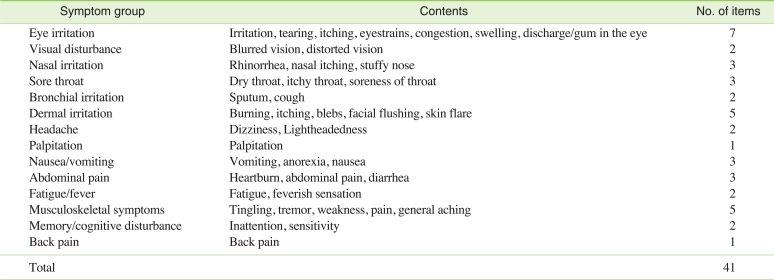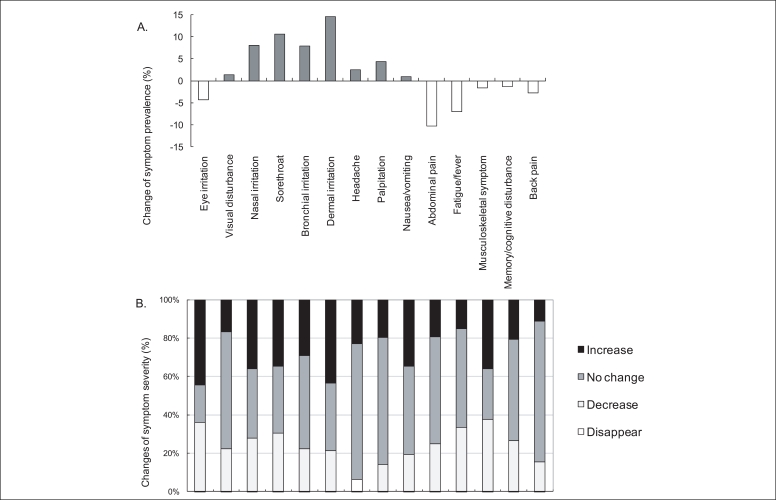Hebei Spirit Oil Spill Exposure and Subjective Symptoms in Residents Participating in Clean-Up Activities
Article information
Abstract
Objectives
This study was conducted to examine the relationship between crude oil exposure and physical symptoms among residents participating in clean-up work associated with the Hebei Spirit oil spill, 2007 in Korea.
Methods
A total of 288 residents responded to a questionnaire regarding subjective physical symptoms, sociodemographic characteristics and clean-up activities that occurred between two and eight weeks after the accident. Additionally, the urine of 154 of the respondents was analyzed for metabolites of volatile organic compounds (VOCs) and polycyclic aromatic hydrocarbons (PAHs) and heavy metals. To compare the urinary levels of exposure biomarkers, the urine of 39 inland residents who were not directly exposed to the oil spill were analyzed.
Results
Residents exposed to oil remnants through clean-up work showed associations between physical symptoms and the exposure levels defined in various ways, including days of work, degree of skin contamination, and levels of some urinary exposure biomarkers of VOCs, metabolites and metals, although no major abnormalities in urinary exposure biomarkers were observed.
Conclusions
This study provides evidence of a relationship between crude oil exposure and acute human health effects and suggests the need for follow-up to evaluate the exposure status and long-term health effects of clean-up participants.
INTRODUCTION
Oil spills, which are one of the most tragic environmental disasters, cause long-term damage to the ecosystem and human health. Oil spills affect human health through both the effects of chemical exposure, as well as the psychological and socioeconomic impact on the affected individuals and the community. Oil spills occur worldwide on various scales, but reports on their health effects are limited. Due to their accidental nature and wide range of coastal devastation, comprehensive and systematic approaches to the human health impact and assessment of environmental exposure levels are rarely made, especially during the initial phase of the accident [1].
Early on the morning of December 7, 2007, an oil tanker, the Hebei Spirit, carrying 263,000 KL of crude oil from the United Arab Emirates to Daesan Harbor on the western coast of Korea crashed into a crane ship, spilling 12,547 KL (about 10,900 tons) of oil into the sea. The oil rapidly spread over 1,052 km or 3,000 ha of coastal line, damaging marine animals and beaches that used to attract millions of people each year by their natural beauty. The coastline of Taeangun county, which had a population of 63,939 in 2006, was most severely hit, resulting in a loss of fishing and tourism for an indefinite period [1].
The accident resulted in a gathering of people from all over Korea to help remove the oil from the coast line. By July 2008, the number of people participating in the clean-up activity reached more than 2 million person-days [2], the majority of which were volunteers. However, local residents, military personnel, national maritime police, and professional workers were most heavily involved in the clean-up, which lasted for several months after the accident. Most of the long-term workers were local fisherman and residents involved in tourist-related industries. However, these workers were not properly protected, especially during the first few days of the accident. As a result, these individuals were exposed to volatile organic compounds (VOCs), polycyclic aromatic hydrocarbons (PAHs) and metals including metallic mercury.
During the clean-up activity, there were several voluntary activities that led to concern regarding the environmental health aspect of the crude oil exposure during the clean-up. At the end of December 2007, the United Committee for Investigation of Acute Health Problems associated with the Hebei Spirit Oil Spill (UCHS) was established. Various academies and institutes, nongovernmental civil organizations, and governmental bodies participated in the UCHS. Specifically, the UCHS collected questionnaires and urine samples from residents, volunteers, military personnel and workers involved in the cleanup, as well as from referents from participating organizations and agencies. The UCHS organized a task force for investigation of the acute health problems caused by the Hebei Spirit oil spill that comprised more than 20 expert researchers in the environmental science, medicine and epidemiology fields from 10 research organizations and universities to conduct the investigation. A comprehensive approach to the early exposure status and acute health effects were made from the results of the collected questionnaires and urinary samples.
This study was conducted to assess the acute health effects and exposure status of the residents involved in the clean-up. The authors also investigated the temporal and spatial relationships between chemical exposure to the oil spill and subjective health complaints, thereby examining the effects of the oil spill on human health.
MATERIALS AND METHODS
I. Subjects
Subjects were recruited from residents of two villages located very close to the oil spill site (20 km southeast and 24 km east), and the other from a village in a small island 65 km southeast of the spill site. The latter village also affected by the degradation product from oil spill of its surrounding coastal line, after days of delay compared to the former two villages. Of the adult residents in the village, those who were involved in at least one day of clean-up were evaluated. The questionnaire survey was administered to and urine sample was collected in 288 people living in the villages and participating in clean-up work during the second to sixth week after the accident. The second survey was performed in 73 residents who responded to the initial survey during the eights week after the accident.
Urine samples were analyzed from 154 of the 288 residents who responded to the questionnaire. In addition, 39 residents who is living in a neighboring inland country that was not affected by the oil spill and who did not participated in the clean up work were recruited as referent subjects for the urine biomarker study.
This study was approved by the Institutional Review Board of Dankook University Hospital. Informed consent was obtained before administration of the questionnaire and collection of urine samples from each subject.
II. Questionnaire
The survey was conducted in the workplace of the residents involved in the clean-up. The questionnaire was self-administered for adults and administered by face-to-face interview for the elderly. The survey included questions about subjective physical symptoms following clean-up work, general characteristics, and past medical history. Forty one representative symptoms were extracted from the literature regarding the health effects of the oil spill [3-7], and these were divided into 14 categories each containing one to seven detailed questions (Table 1). Demographic characteristics, personal health behavior including smoking and disease history, and details regarding the clean-up work, including days and duration of work, work position, use of protective device, and degree of skin contamination with the oil product during the work were evaluated using semi-quantitative, self evaluated questionnaire (never, little, much and profound). Variables representing exposure to crude oil, days of clean-up work was categorized to less than 10 days, 10 to less than 13, 13 to less than 20, 20 or more days, where 10 days implied about 2 weeks work since the accident when the earliest survey was performed.
III. Urinary Metabolites
Fresh spot urine was collected into a sampling bottle within less than an hour after finishing clean-up work for the day. The samples were labeled and then immediately stored in a mobile refrigerator at -20℃ until they were transferred to a refrigerator in the laboratory, where they were stored at -20℃. Among numerous chemicals in crude oil, some portion of the crude oil including VOCs and metallic mercury, is volatile, which evaporates mostly within one week of disposal. When it is exposed to sea water, seasoning process accelerates the change of physicochemical properties of the original oil. We assayed for most common metabolites of VOCs (t,t-muconic acid for benzene, hippuric acid for toluene, methyl hippuric acid for xylene, and mandelic acid for styrene) and two metabolites of PAHs (β-naphthol and 1-hydroxypyrene), and five metals (lead, mercury, manganese, nickel, and cadmium) on 197 urine samples from residents involved in the clean-up and from the referents.
We measured the urinary t,t-muconic acid, mandelic acid, hippuric acid, and methyl hippuric acid by high performance liquid chromatography (HPLC)(Agilent 1200, Agilent, San Jose, CA, USA). Urinary t,t-muconic acid was measured after solid phase extraction (SPE) as previously described [8]. Urinary mandelic acid, hippuric acid and methyl hippuric acid were measured in urine using reverse-phase HPLC as previously described [9].
Analysis of the urinary metabolites of PAHs, β-naphthol and 1-hydroxypyrene, was conducted using a HPLC-fluorescence detector (Agilent 1200 series; Agilent, San Jose, CA, USA) after enzymatic hydrolysis, as previously described [10,11].
Urine was also analyzed for the presence of five metals, lead, mercury, manganese, nickel, and cadmium using ICP-MS (ELAN DRC-e, Perkin-Elmer, Singapore). For the analysis of urinary metals, urine samples were stored in test tubes pretreated with acid. After filling half level of the acidtreated 1 L volumetric flask with 18 MΩ water, 20 mL of concentrated HNO3 was added and rest of the volume was filled with 18 MΩ water to the indicator. Prepared specimen was stored in room temperature until analysis. Mercury was measured using a Direct Mercury Analyzer (DMA-80, Milestone, Shelton, CT, USA), while all other compounds were measured by inductively coupled plasma-mass spectrometry (ICP-MS, ELAN DRC-e, Perkin-Elmer, Singapore).
Urine creatitnine level was measured for the quantitative assessment of urinary metals and metabolites.
IV. Statistical Analysis
We described the symptoms with respect to involvement in clean-up, including the duration and intensity of the work and changes in the symptoms after various time intervals. Changes in the symptom complaints over 5-week period in the 73 residents who responded to the repeated questionnaire survey were described.
The level of exposure to chemicals in the crude oil was estimated using urinary metabolites and metal levels by comparing the residents who participated in the clean-up with referents. Among the exposed residents, urinary metabolites and metal levels were categorized into two groups based on the median value of each metabolite and metal. The odds ratio for each symptom and their 95% confidence interval was estimated for each metabolite and metal using a multiple logistic regression model adjusted for age, gender, educational level, history of asthma, nearby pollution source, and health belief regarding the oil spill. Statistical analysis was conducted using SAS version 9.1 (SAS Inc., Cary, NC, USA).
RESULTS
I. Characteristics of the Study Subjects
Women were slightly dominant and more than half were aged more than 60 years old (Table 2). More than half of the residents worked in the fishing or agriculture industries. The educational level was generally low, with almost half of the residents were educated for six or less years. More than 80% of the residents had monthly incomes of less than 2,000,000 Korean won (1,500 USD). Additionally, 21.5% were smokers.
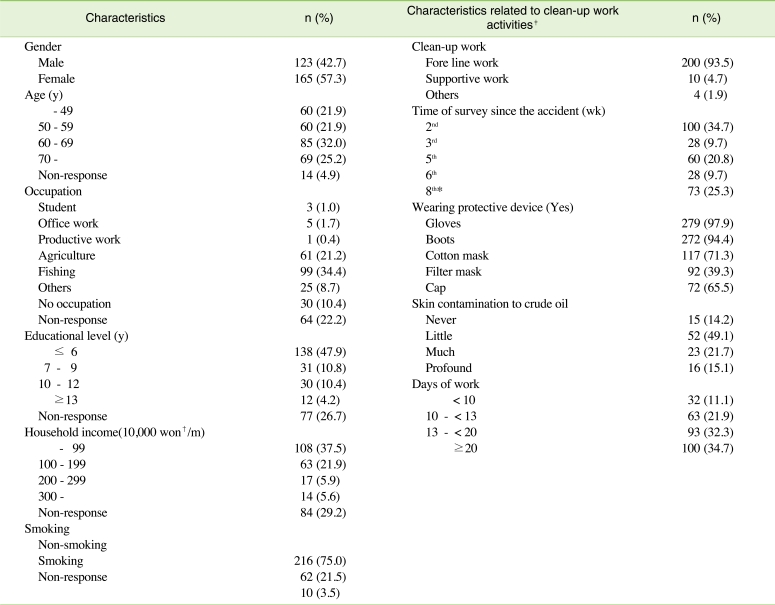
Characteristics of the study subjects participating in clean-up of the Hebei Spirit oil spill, Taean, Korea, 2007-2008 (N=288)
Overall, 94% of the respondents participated in the clean-up as a foreman and 55.8% worked for more than three weeks. The proportion of the residents who wore personal protective devices during clean-up was greater than 90%, but the level that wore adequate filter masks and caps was only 39.3% and 65.5%, respectively.
II. Urinary Metals and Metabolites
In urinary metabolites of VOCs, only mandelic acid concentration was higher in clean-up participants than in referents in borderline level (p=0.06). Mandelic acid concentration was higher in samples of 5th-6th week than those of 2nd-3rd week among clean-up participants (p=0.05)(Table 3).
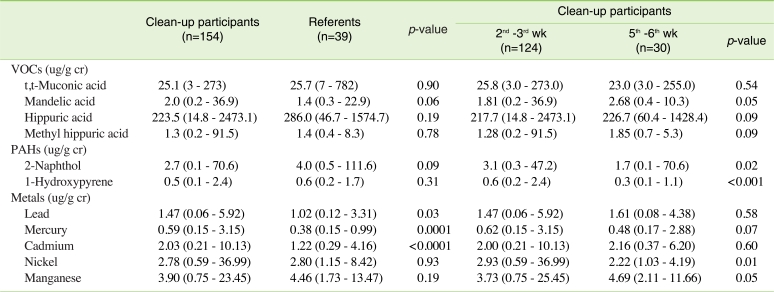
Levels of biological exposure markers by exposure status and time since the accident in residents participating in clean-up of the Hebei Spirit oil spill, Taean, Korea, 2007-2008 (unit; geometric mean and range)
The urinary metabolites of PAHs did not show significant difference between clean-up participants and referents. The samples of 2nd-3rd week in the clean-up work participants showed significantly higher levels of both 2-naphthol and 1-hydroxypyrene than those of 5th-6th week (p =0.02 and <0.001, respectively)(Table 3).
The urinary concentration lead, mercury, and cadmium were significantly higher in clean-up participants than in referents. Among the samples of the clean-up work participants, the nickel concentration was significantly lower in 5th-6th week than 2nd-3rd week (p=0.01), while the manganese was higher in borderline level (p=0.05)(Table 3).
III. Self-reported Symptoms
Subjective physical symptoms were reported in 42% to 82% of the residents, although this level decreased during the 2nd, 3rd, and 5th week, and then increased again at week 6 and 8 (Table 4). The symptom positive rate increased significantly according to the number of days of clean-up work and increasing degree of skin contamination with crude oil in most symptoms (Table 5). The symptoms rarely decreased from week 2 to week 8 among those surveyed repeatedly (Figure 1-A), and more than 60% of the respondents reported no-change or increased symptoms (Figure 1-B).
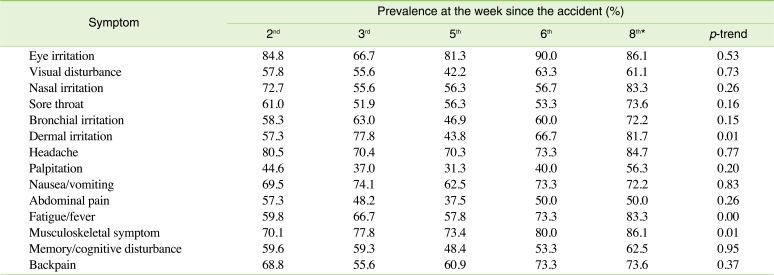
Prevalence of subjective physical symptoms by time after the accident among 288 residents participating in clean-up work, Taean, Korea, 2007-2008
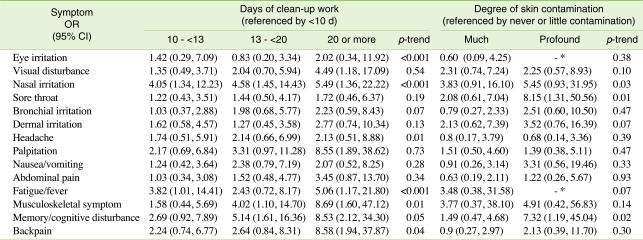
Risk of subjective physical symptoms according to increasing days of clean-up work and degree of skin contamination by crude oil among 288 residents participating in clean-up of the Hebei Spirit oil spill, Taean, Korea, 2007-2008
IV. Physical Symptoms According to the Level of Urinary Metals and Metabolites
Residents whose urinary hippuric acid level was higher than the median level reported significantly increased symptoms of nasal irritation odds ratio [OR], 2.97; 95% confidence interval [CI], 1.30 to 6.79), nausea and vomiting sensation (OR, 3.01; 95% CI, 1.22 to 7.42), while those whose urinary methyl-hippuric acid level was higher than the median level more frequently reported fatigue and fever (OR, 4.38; 95% CI, 1.25 to 15.37) than those whose urinary level was median or lower (Figure 2). Residents with higher levels of 1-hydroxypyrene showed four times more musculoskeletal symptoms (OR, 4.16; 95% CI, 1.10 to 15.68). Eye irritation symptoms were reported 20 times more often and skin irritation symptoms were reported five times more often among those with higher lead levels. Eye irritation symptoms were reported five times more often among individuals with higher urinary mercury levels. Skin irritation symptoms were reported two times more frequently and headache and palpitation was two to four times higher among individuals with higher urinary nickel and cadmium levels, respectively.
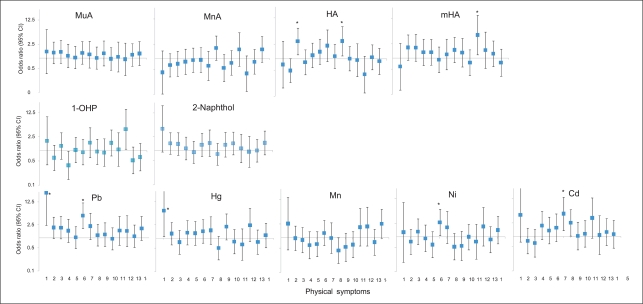
Risk of physical symptoms accoding to the level of urinary VOCs and PAHs metabolites and metals in 154 residents pariticipating in clean-up of the Hebei Spirit oil spill, Taean, Korean, 2007-2008.
Physical symptoms 1: eye irritation, 2: visual disturbance, 3: nasal irritation, 4: sore throat, 5: bronchial irritation, 6: dermal irritation, 7: headache, 8: palpitation, 9: nausea/vomiting, 10: abdominal pain, 11: fatigue/fever, 12: musculoskeletal symptoms, 13: memory/coginitive disturbance, 14: back pain.
MA: t,t-muconic acid, MnA: mandelic acid, HA: hippuric acid, mHA: methyl hippuric acid, 1-OHP: 1-hydroxypyrene, 2-Naphthol: β-naphthol, Pb: lead, Hg: mercury, Mn: manganese, Ni: nickel, Cd: cadmium, VOCs: volatile organic compounds, PAHs: polycyclic aromatic hydrocarbons.
Odds ratio and 95% confidence intervals of people whose urinary level was in the upper half referenced by those with levels in the lower half, estimated using multiple logistic regression model adjusted for age, gender, history of asthma diagnosed, health belief regarding oil spill.
Statistically significantly increased risk of physical symptoms in individuals whose urinary level was in the upper half compared to those with levels in the lower half.
DISCUSSION
Residents exposed to oil remnants through clean-up work showed associations between physical symptoms and the exposure levels defined by the days of work, degree of skin contamination, and levels of some urinary exposure biomarkers of VOC metabolites and metals, although major abnormalities of urinary exposure biomarkers were absent.
The Hebei Spirit spilled three kinds of crude oil from Iran, the United Arab Emirates, and Kuwait, which were composed of a multitude of chemicals including various VOCs, PAHs, and metals [12]. Acute health effects on the residents of the coastal area affected by an oil spill are related to the initial VOCs exposure via evaporation of crude oil on the sea water surface and attached to the beach, which usually lasts for one week after a spill [13]. After this initial period, most of the exposure to the oil components occurs during the clean-up. Most of the clean-up work in the coastal area was conducted by manual removal of the attached oil remnants using absorbents or simple instruments such as buckets. This cleanup required more than 2 million person-days over six months. Other methods, including the use of pressured steam or dispersant, which can lead to secondary health hazards [14], were only used in a limited capacity along the coast; therefore, health effects of the residents after the accident were primarily related to the clean-up, and the main exposure occurred through the respiratory tract and skin [12]. The physical symptoms reported by the clean-up participants in this study generally consisted of irritation, which is consistent with the results of previous studies [3-7,15]. The symptom prevalence in visual disturbance, nausia/vomiting, abdominal pain, palpitation, and skin irritation decreased from 2nd or 3rd week to 4th or 5th week and then increased at 6th and 8th week while others continuously increased from earlier time to later. The crude oil initially evaporated strong volatile chemicals and then abruptly decreased in one or two weeks while PAHs evaporated slowly and continuously. Therefore, during working in contaminated coasts, the irritation symptoms mainly due to VOC exposure decreased accordingly. However, the long term clean-up work accumulated the people's fatigue and musculoskeletal symptoms and then might increase physical symptoms other than irritation. Furthermore, there were some variation in the survey areas and population according to the survey time which might influence to the pattern of symptom prevalence throughout the time.
This study was conducted from the second week of the accident; therefore, it is one of the earliest studies conducted after an oil spill accident [1]. The number of subjects in this study was also relatively larger than previous studies conducted within 2 weeks of an accident, which have generally included than one hundred individuals [16-18]. Furthermore, this study measured various exposure biomarkers among people exposed to crude oil, including 4 VOC metabolites, 2 PAH metabolites and 5 metals; therefore, it was more comprehensive than studies conducted after the Nakhodka oil spill [6] and the Braer accident [7], where only 4 VOC metabolites and hippuric acid were measured, respectively. The levels of exposure biomarkers of VOCs were not demonstrably high among the exposed population or clean-up participants in any studies that have been conducted to date [6,7], or in the present study. These findings may be due to other sources of exposure or because too much time passed between exposure and urine collection. The findings that the geometric means of VOC metabolites seemed to increase from 2nd-3rd week to 4th-5th week while those of PAH and metals showed to decrease might be explained due to the different time point of urine sampling in a day for each group and shorter biological half life of VOC metabolites.
This study was based on convenient samples of clean-up participants including investigators from studies conducted by several academia and civic groups. Therefore, the study subjects might not represent those who participated in clean-up of the Hebei Spirit oil spill well, although there was no evidence of selection bias observed.
We were not able to determine the actual ambient exposure levels of crude oil immediately after the accident, which prevented us from assessing the relationship between ambient exposure of crude oil and health effects in the affected area. The measurement time point was also not appropriate for some exposure biomarkers evaluated in the present study, particularly VOCs metabolites, which generally have biological half lives of only several hours.
The self-report symptoms are subjective, and residents in the exposure area might exaggerate their symptoms; therefore a misclassification bias differential according to the exposure status might not be excluded. However, the fact that the complaint of symptoms increased as the days of the clean-up work increased indicates that the symptoms were actually associated with the hazardous effects of crude oil exposure.
Crude oil contains various carcinogenic materials and studies of genotoxic effects have been conducted in previous oil spill accidents [19-23]. We did not assess the genotoxic effects of the Hebei Spirit oil spill exposure; therefore, future long-term studies are warranted. Furthermore, the follow-up monitoring of crude oil exposure in multiple media are needed.
CONCLUSIONS
In this study, we demonstrated that the severity and frequency of symptoms associated with the level of exposure to clean up work occurred in a dose-dependent manner. Considering the vast area of involvement and emergency nature of the oil spill accident, this survey of the physical symptoms of the workers exposed to oil during clean up can provide insight into the health effects of oil spills in the exposed population.
ACKNOWLEDGEMENTS
This study was supported by a special grant for the Investigation of Acute Health Effects of the Hebei Spirit Oil Spill, Ministry of Environment, Republic of Korea, 2008.
Notes
The authors have no conflict of interest to declare on this study.
This article is available from: http://e-eht.org/
